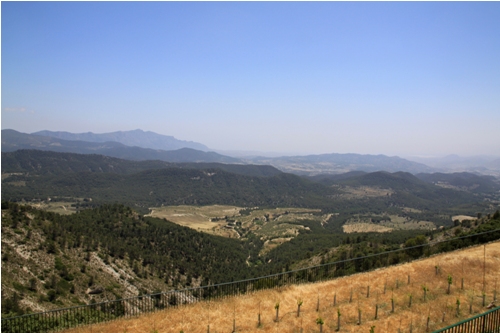Le Pou de la Neu
 Friday, August 31, 2012 at 6:09PM
Friday, August 31, 2012 at 6:09PM Most people are willing to pay a lot of money to dine in front of a view like this.

At Le Pou de la Neu you don’t have to. Our group of nine managed to get away with 40 euros per head – that bought us 8 starters (which could well have passed for main courses), 9 mains, 4 desserts to share and 6 bottles of fabulous local wines.
Le Pou de la Neu is a hotel and restaurant set in the mountains above the village of Jijona in the Alicante province, Spain. Jijona, or Xixona in Valenciano, is famous for their Turrón de Jijona – a type of nougat made with almonds. This appears on the restaurant menu, along with a number of other local delicacies. The focus of the menu is very much on regional produce and recipes.
Sadly, the restaurant is not very well frequented. Our hosts, Gayle and Gilpin, who live in a small village nearby, have brought many guests here and say that they are usually the only customers. On the bright side, it was very pleasant having the place to ourselves – we got the best table in the house and the undivided attention of a rather nervous, but very sweet waiter who took pains to answer all of my questions making several journeys to the kitchen to confer with the chef.
For starters we shared four dishes, ordering two of each at my suggestion so there would be enough to go around. The portions were extremely generous so we probably didn’t need this much, but it was so delicious that we finished it all regardless.
The pericana is a house specialty and came highly recommended by Gilpin. Pericana is a type of sauce originating in l'Alcoià comarca in the north of the Alicante province. It is made from dried red peppers or dried tomatoes mixed with plenty of olive oil and garlic. It is usually served with fish, in this case bacalao, and crisp toast. The salt cod was well balanced with the sweet peppers and there was more olive oil and garlic than you would ever dare to use at home; a true taste of Spain.
Queso con miel (cheese with honey) was surprisingly delicious; one expects this sort of thing to be good, but not stand out. The quality of the produce obviously had a lot to do with it. The cheese was local, a sheep’s milk cheese similar to Manchego. It was at the stage I like it best – mature enough to have developed a strong flavour but young enough to still have a smooth texture. The sweetness of the honey, which had a slight hint of rosemary, contrasted beautifully.

It’s not often that a plate of ham can be called a dish in its own right. It’s not often that it is not screaming out for something. Jamon iberico manages to achieve this.

Deep red, savoury meat trimmed with silky fat. What more do you need?
The favourite for me was the revueltos con setas (scrambled eggs with wild mushrooms). The eggs, cooked in olive oil and garlic, were a perfectly creamy consistency, a great contrast to the crispy toast. The mushrooms, clearly picked locally, had that deep, earthy flavour you never get in those which have travelled a long way.

My Mum and I shared the bacalao and the lamb chops for mains. I preferred the bacalao, which came in a creamy cheese sauce, with spinach and potatoes. It was quite rich, but the potatoes helped to soak up the cream and counterbalance the very salty fish and the spinach added a lighter note. Still, I think I would have struggled if I hadn’t been sharing.

My Dad had visited on another occasion and said the lamb chops were the best he’d ever eaten. This may be why I was a little disappointed. They did have a great flavour, almost mutton-like, but they were overcooked, not a hint of pink. I should have come to expect that in Spain though really.
Overall, the starters were best and they are so big you could happily come and share them like tapas in place of main courses. Desserts can be shared too, and we did, ordering the obligatory Turron de Jijona and an ice cream flavoured like it.

Since I prefer savouries my contribution to the selection was the pan con chocolate y aciete (bread with chocolate and olive oil). I have noticed that chocolate and olive oil are becoming a fashionable combination in top-end London restaurants, where they are used as ingredients in more complex or refined desserts. I prefer the traditional Spanish way, which is more rustic, quite literally as it sounds – crunchy bread served with pieces of dark chocolate and olive oil to drizzle over. Yum.
So it is clear that the lack of customers bares no relation to the venue or the food – both of which are fantastic. An obscure location and poor marketing are the more likely culprits. The website was difficult to find and then only in Spanish and the restaurant can only be accessed by car; you wouldn’t know it was there unless someone told you.
So I am telling you. If you happen to be holidaying in the Alicante region, do make an effort to go there. I promise it will be worth it.

 Vix |
Vix |  Post a Comment |
Post a Comment | 
Reader Comments